warning light TOYOTA LAND CRUISER 2020 Warranties & Maintenance Guides (in English)
[x] Cancel search | Manufacturer: TOYOTA, Model Year: 2020, Model line: LAND CRUISER, Model: TOYOTA LAND CRUISER 2020Pages: 260, PDF Size: 8.54 MB
Page 4 of 260
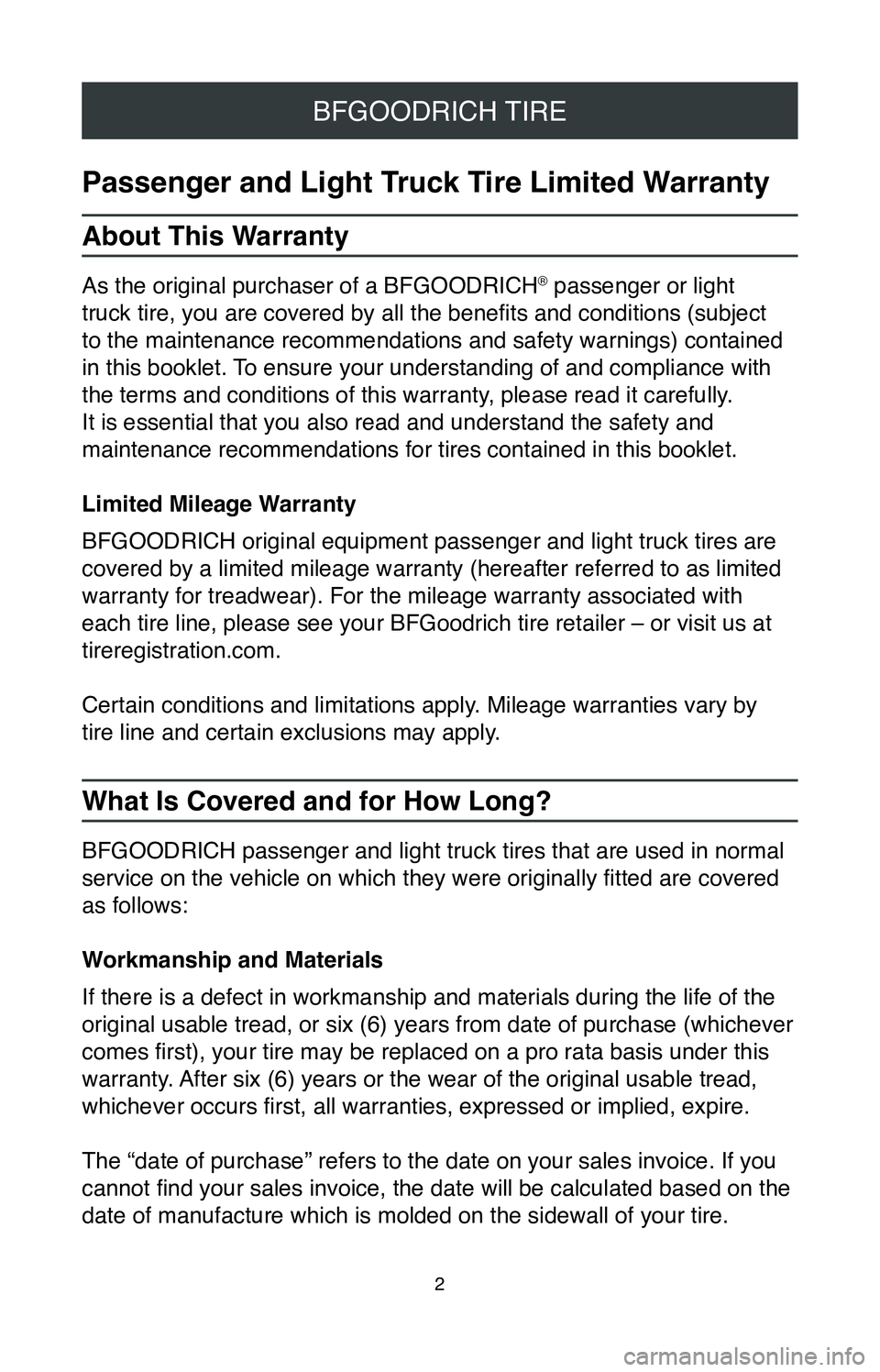
2
BFGOODRICH TIRE
Passenger and Light Truck Tire Limited Warranty
About This Warranty
As the original purchaser of a BFGOODRICH® passenger or light
truck tire, you are covered by all the benefits and conditions (subject
to the maintenance recommendations and safety warnings) contained
in this booklet. To ensure your understanding of and compliance with
the terms and conditions of this warranty, please read it carefully.
It is essential that you also read and understand the safety and
maintenance recommendations for tires contained in this booklet.
Limited Mileage Warranty
BFGOODRICH original equipment passenger and light truck tires are
covered by a limited mileage warranty (hereafter referred to as limited
warranty for treadwear). For the mileage warranty associated with
each tire line, please see your BFGoodrich tire retailer – or visit u\
s at
tireregistration.com.
Certain conditions and limitations apply. Mileage warranties vary by
tire line and certain exclusions may apply.
What Is Covered and for How Long?
BFGOODRICH passenger and light truck tires that are used in normal
service on the vehicle on which they were originally fitted are covered
as follows:
Workmanship and Materials
If there is a defect in workmanship and materials during the life of the\
original usable tread, or six (6) years from date of purchase (whichever
comes first), your tire may be replaced on a pro rata basis under this
warranty. After six (6) years or the wear of the original usable tread,
whichever occurs first, all warranties, expressed or implied, expire.
The “date of purchase” refers to the date on your sales invoice. I\
f you
cannot find your sales invoice, the date will be calculated based on the
date of manufacture which is molded on the sidewall of your tire.
Page 46 of 260
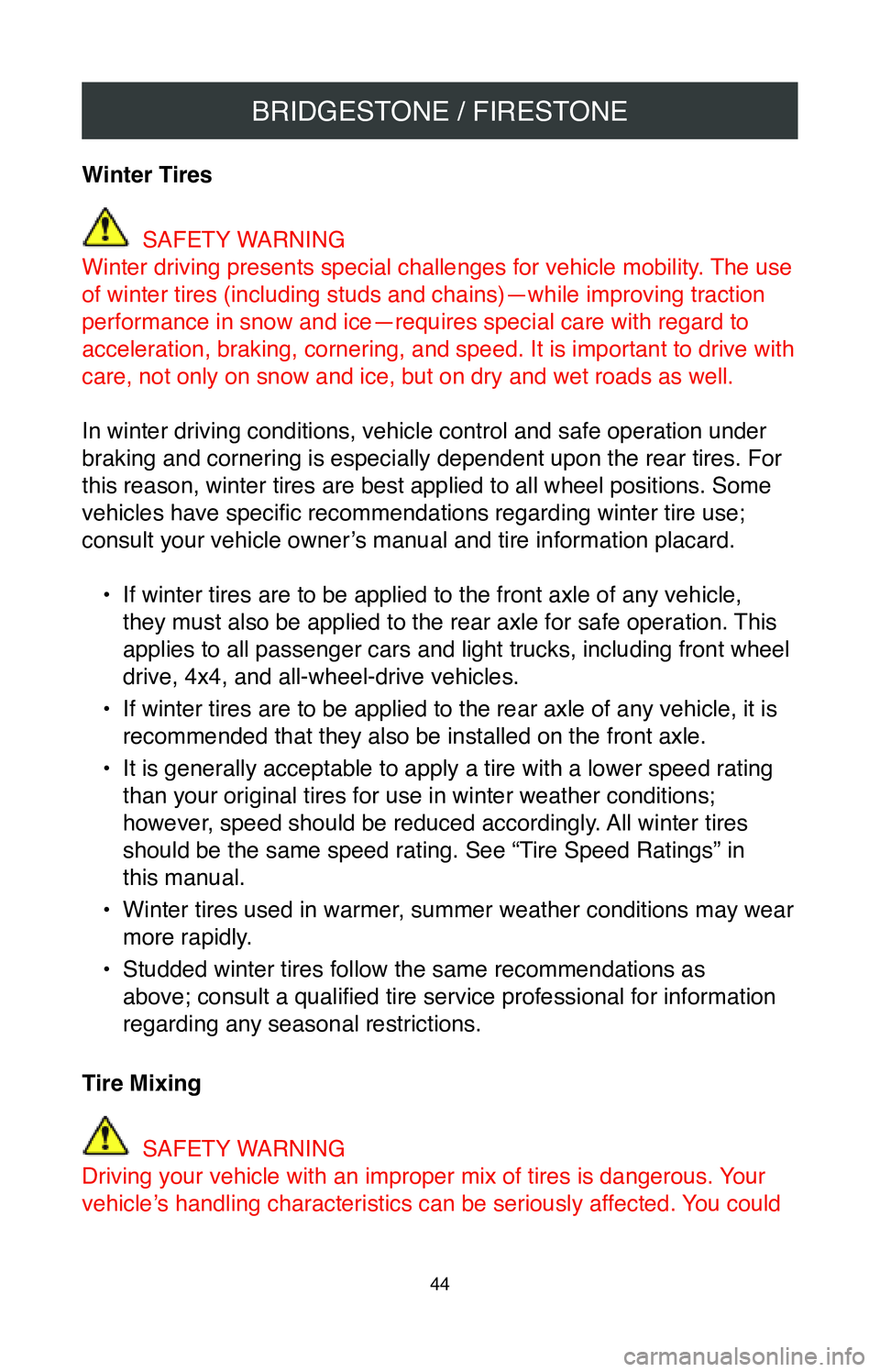
BRIDGESTONE / FIRESTONE
44
Winter Tires
SAFETY WARNING
Winter driving presents special challenges for vehicle mobility. The use
of winter tires (including studs and chains)—while improving traction
performance in snow and ice—requires special care with regard to
acceleration, braking, cornering, and speed. It is important to drive wi\
th
care, not only on snow and ice, but on dry and wet roads as well.
In winter driving conditions, vehicle control and safe operation under
braking and cornering is especially dependent upon the rear tires. For
this reason, winter tires are best applied to all wheel positions. Some \
vehicles have specific recommendations regarding winter tire use;
consult your vehicle owner’s manual and tire information placard.
•
If winter tires are to be applied to the front axle of any vehicle,
they must also be applied to the rear axle for safe operation. This
applies to all passenger cars and light trucks, including front wheel
drive, 4x4, and all-wheel-drive vehicles.
•
If winter tires are to be applied to the rear axle of any vehicle, it is\
recommended that they also be installed on the front axle.
•
It is generally acceptable to apply a tire with a lower speed rating
than your original tires for use in winter weather conditions;
however, speed should be reduced accordingly. All winter tires
should be the same speed rating. See “Tire Speed Ratings” in
this manual.
•
Winter tires used in warmer, summer weather conditions may wear
more rapidly.
•
Studded winter tires follow the same recommendations as
above; consult a qualified tire service professional for information
regarding any seasonal restrictions.
Tire Mixing
SAFETY WARNING
Driving your vehicle with an improper mix of tires is dangerous. Your
vehicle’s handling characteristics can be seriously affected. You could
Page 52 of 260
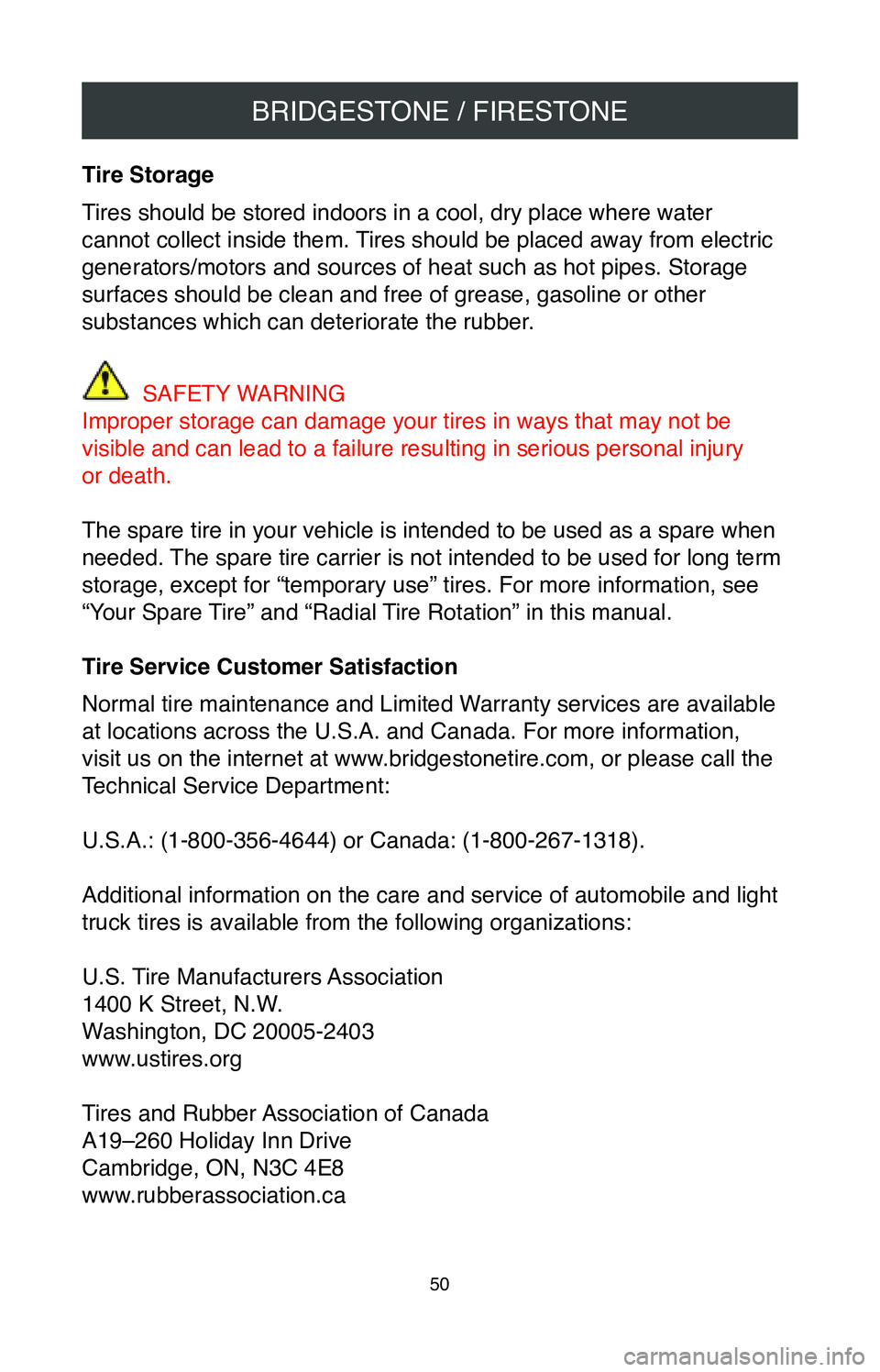
BRIDGESTONE / FIRESTONE
50
Tire Storage
Tires should be stored indoors in a cool, dry place where water
cannot collect inside them. Tires should be placed away from electric
generators/motors and sources of heat such as hot pipes. Storage
surfaces should be clean and free of grease, gasoline or other
substances which can deteriorate the rubber.
SAFETY WARNING
Improper storage can damage your tires in ways that may not be
visible and can lead to a failure resulting in serious personal injury
or death.
The spare tire in your vehicle is intended to be used as a spare when
needed. The spare tire carrier is not intended to be used for long term
storage, except for “temporary use” tires. For more information, s\
ee
“Your Spare Tire” and “Radial Tire Rotation” in this manual.
Tire Service Customer Satisfaction
Normal tire maintenance and Limited Warranty services are available
at locations across the U.S.A. and Canada. For more information,
visit us on the internet at www.bridgestonetire.com, or please call the
Technical Service Department:
U.S.A.: (1-800-356-4644) or Canada: (1-800-267-1318).
Additional information on the care and service of automobile and light
truck tires is available from the following organizations:
U.S. Tire Manufacturers Association
1400 K Street, N.W.
Washington, DC 20005-2403
www.ustires.org
Tires and Rubber Association of Canada
A19–260 Holiday Inn Drive
Cambridge, ON, N3C 4E8
www.rubberassociation.ca
Page 78 of 260
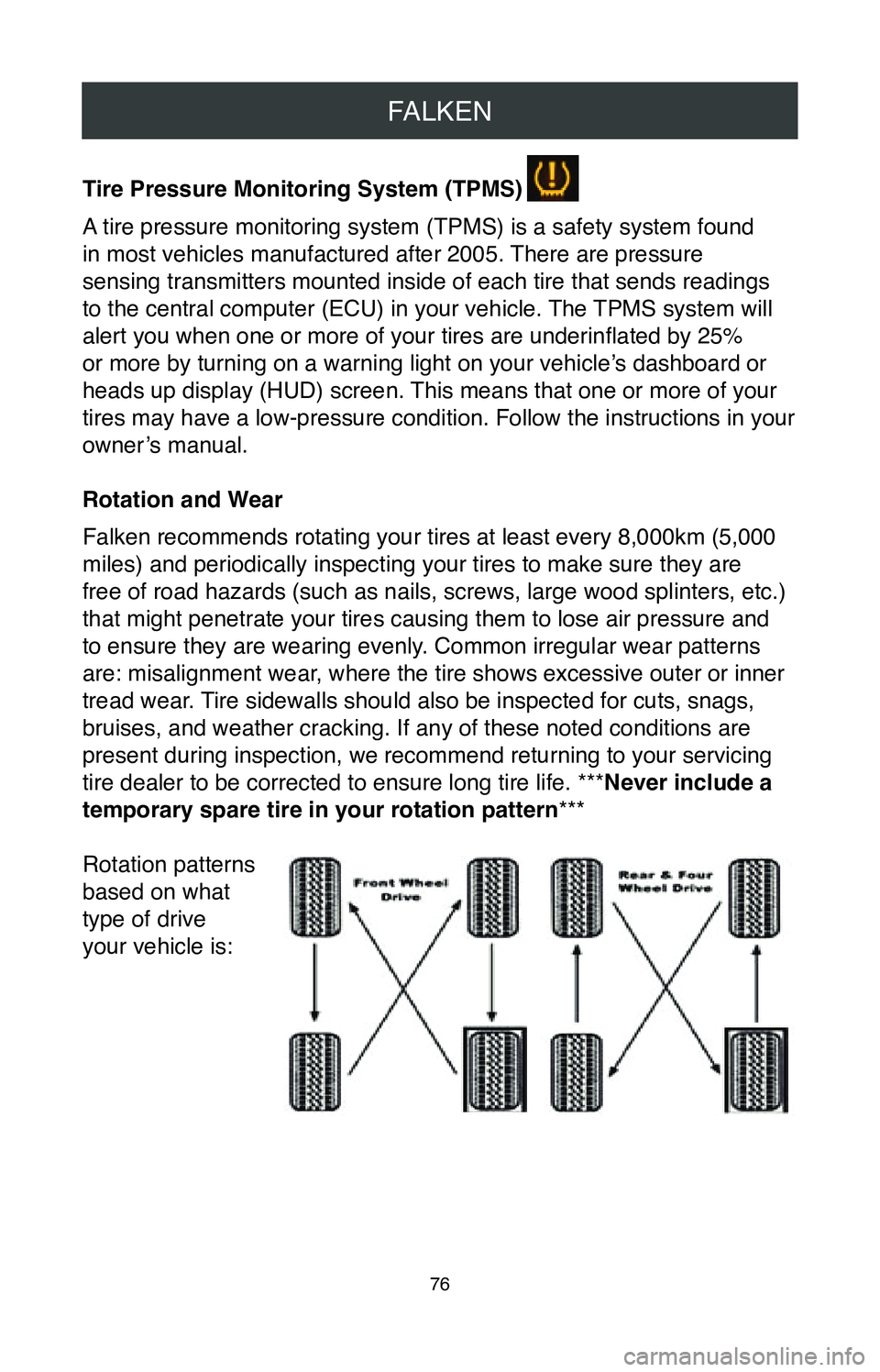
FALKEN
76
Tire Pressure Monitoring System (TPMS)
A tire pressure monitoring system (TPMS) is a safety system found
in most vehicles manufactured after 2005. There are pressure
sensing transmitters mounted inside of each tire that sends readings
to the central computer (ECU) in your vehicle. The TPMS system will
alert you when one or more of your tires are underinflated by 25%
or more by turning on a warning light on your vehicle’s dashboard or
heads up display (HUD) screen. This means that one or more of your
tires may have a low-pressure condition. Follow the instructions in your
owner’s manual.
Rotation and Wear
Falken recommends rotating your tires at least every 8,000km (5,000
miles) and periodically inspecting your tires to make sure they are
free of road hazards (such as nails, screws, large wood splinters, etc.)
that might penetrate your tires causing them to lose air pressure and
to ensure they are wearing evenly. Common irregular wear patterns
are: misalignment wear, where the tire shows excessive outer or inner
tread wear. Tire sidewalls should also be inspected for cuts, snags,
bruises, and weather cracking. If any of these noted conditions are
present during inspection, we recommend returning to your servicing
tire dealer to be corrected to ensure long tire life. ***Never include a
temporary spare tire in your rotation pattern***
Rotation patterns
based on what
type of drive
your vehicle is:
Page 81 of 260
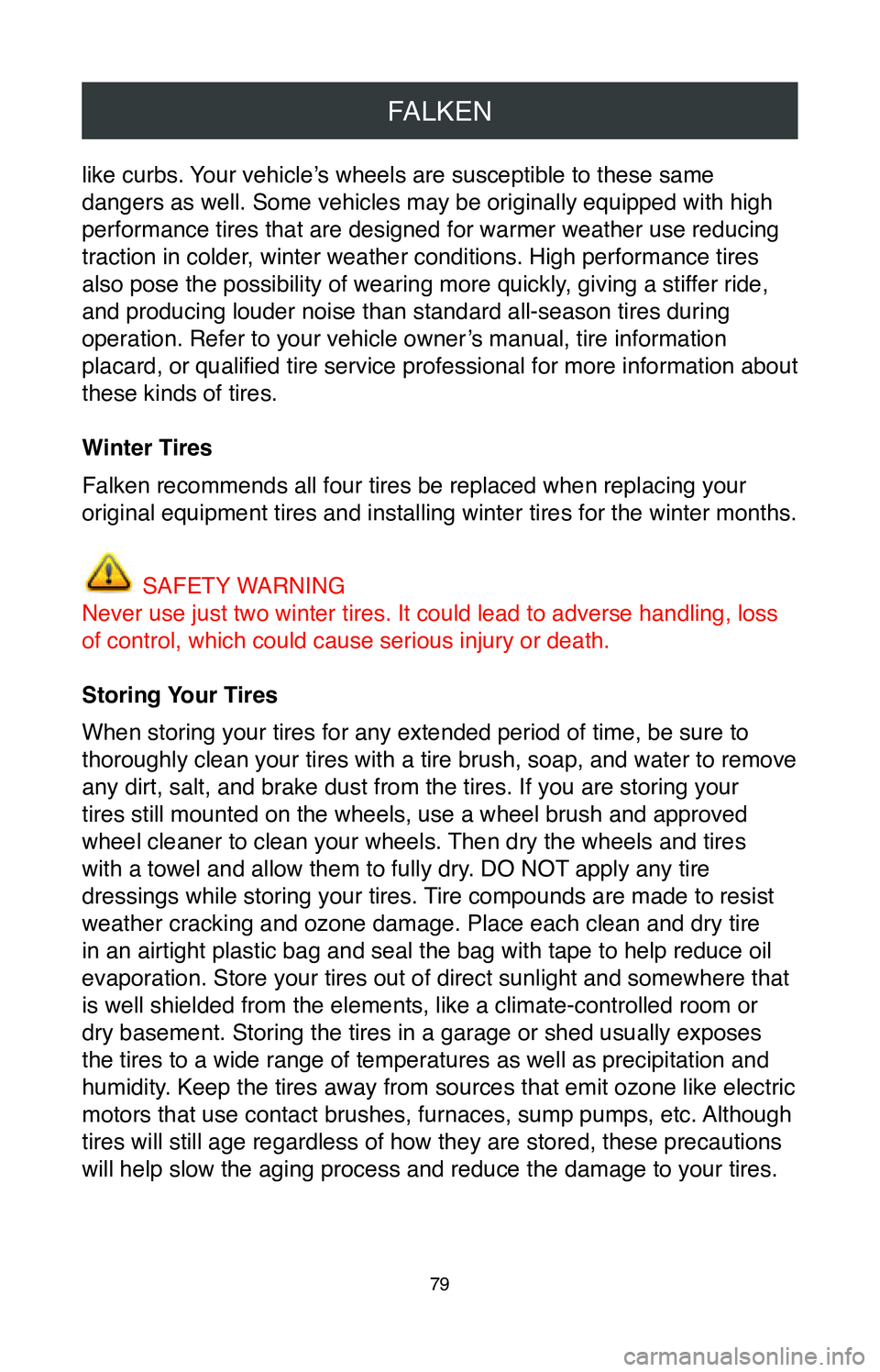
FALKEN
79
like curbs. Your vehicle’s wheels are susceptible to these same
dangers as well. Some vehicles may be originally equipped with high
performance tires that are designed for warmer weather use reducing
traction in colder, winter weather conditions. High performance tires
also pose the possibility of wearing more quickly, giving a stiffer ride,
and producing louder noise than standard all-season tires during
operation. Refer to your vehicle owner’s manual, tire information
placard, or qualified tire service professional for more information about
these kinds of tires.
Winter Tires
Falken recommends all four tires be replaced when replacing your
original equipment tires and installing winter tires for the winter mont\
hs.
SAFETY WARNING
Never use just two winter tires. It could lead to adverse handling, loss
of control, which could cause serious injury or death.
Storing Your Tires
When storing your tires for any extended period of time, be sure to
thoroughly clean your tires with a tire brush, soap, and water to remove\
any dirt, salt, and brake dust from the tires. If you are storing your
tires still mounted on the wheels, use a wheel brush and approved
wheel cleaner to clean your wheels. Then dry the wheels and tires
with a towel and allow them to fully dry. DO NOT apply any tire
dressings while storing your tires. Tire compounds are made to resist
weather cracking and ozone damage. Place each clean and dry tire
in an airtight plastic bag and seal the bag with tape to help reduce oil\
evaporation. Store your tires out of direct sunlight and somewhere that \
is well shielded from the elements, like a climate-controlled room or
dry basement. Storing the tires in a garage or shed usually exposes
the tires to a wide range of temperatures as well as precipitation and
humidity. Keep the tires away from sources that emit ozone like electric
motors that use contact brushes, furnaces, sump pumps, etc. Although
tires will still age regardless of how they are stored, these precaution\
s
will help slow the aging process and reduce the damage to your tires.
Page 82 of 260
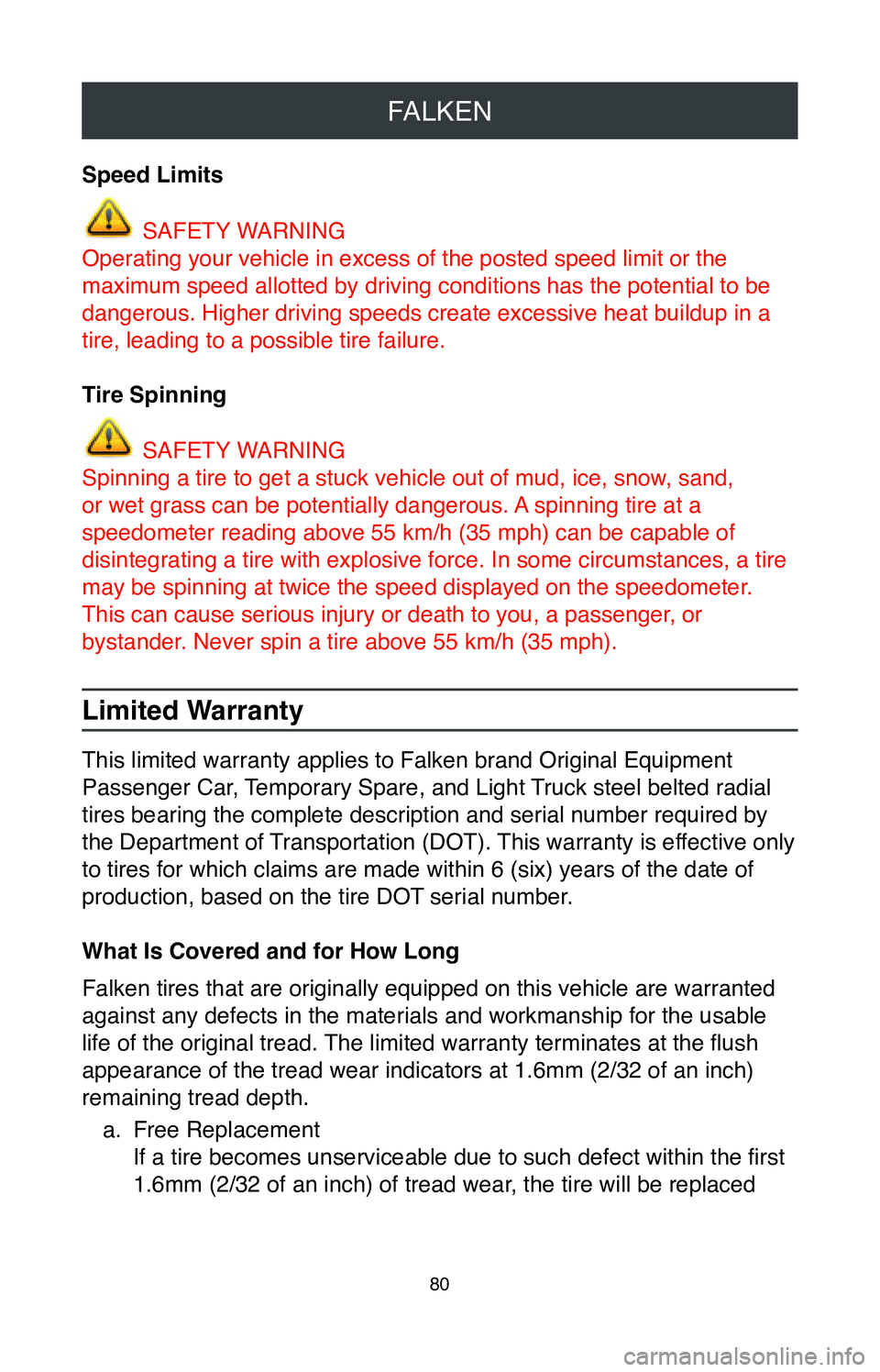
FALKEN
80
Speed Limits
SAFETY WARNING
Operating your vehicle in excess of the posted speed limit or the
maximum speed allotted by driving conditions has the potential to be
dangerous. Higher driving speeds create excessive heat buildup in a
tire, leading to a possible tire failure.
Tire Spinning
SAFETY WARNING
Spinning a tire to get a stuck vehicle out of mud, ice, snow, sand,
or wet grass can be potentially dangerous. A spinning tire at a
speedometer reading above 55 km/h (35 mph) can be capable of
disintegrating a tire with explosive force. In some circumstances, a tir\
e
may be spinning at twice the speed displayed on the speedometer.
This can cause serious injury or death to you, a passenger, or
bystander. Never spin a tire above 55 km/h (35 mph).
Limited Warranty
This limited warranty applies to Falken brand Original Equipment
Passenger Car, Temporary Spare, and Light Truck steel belted radial
tires bearing the complete description and serial number required by
the Department of Transportation (DOT). This warranty is effective only
to tires for which claims are made within 6 (six) years of the date of
production, based on the tire DOT serial number.
What Is Covered and for How Long
Falken tires that are originally equipped on this vehicle are warranted \
against any defects in the materials and workmanship for the usable
life of the original tread. The limited warranty terminates at the flush
appearance of the tread wear indicators at 1.6mm (2/32 of an inch)
remaining tread depth.
a.
Free Replacement
If a tire becomes unserviceable due to such defect within the first
1.6mm (2/32 of an inch) of tread wear, the tire will be replaced
Page 119 of 260
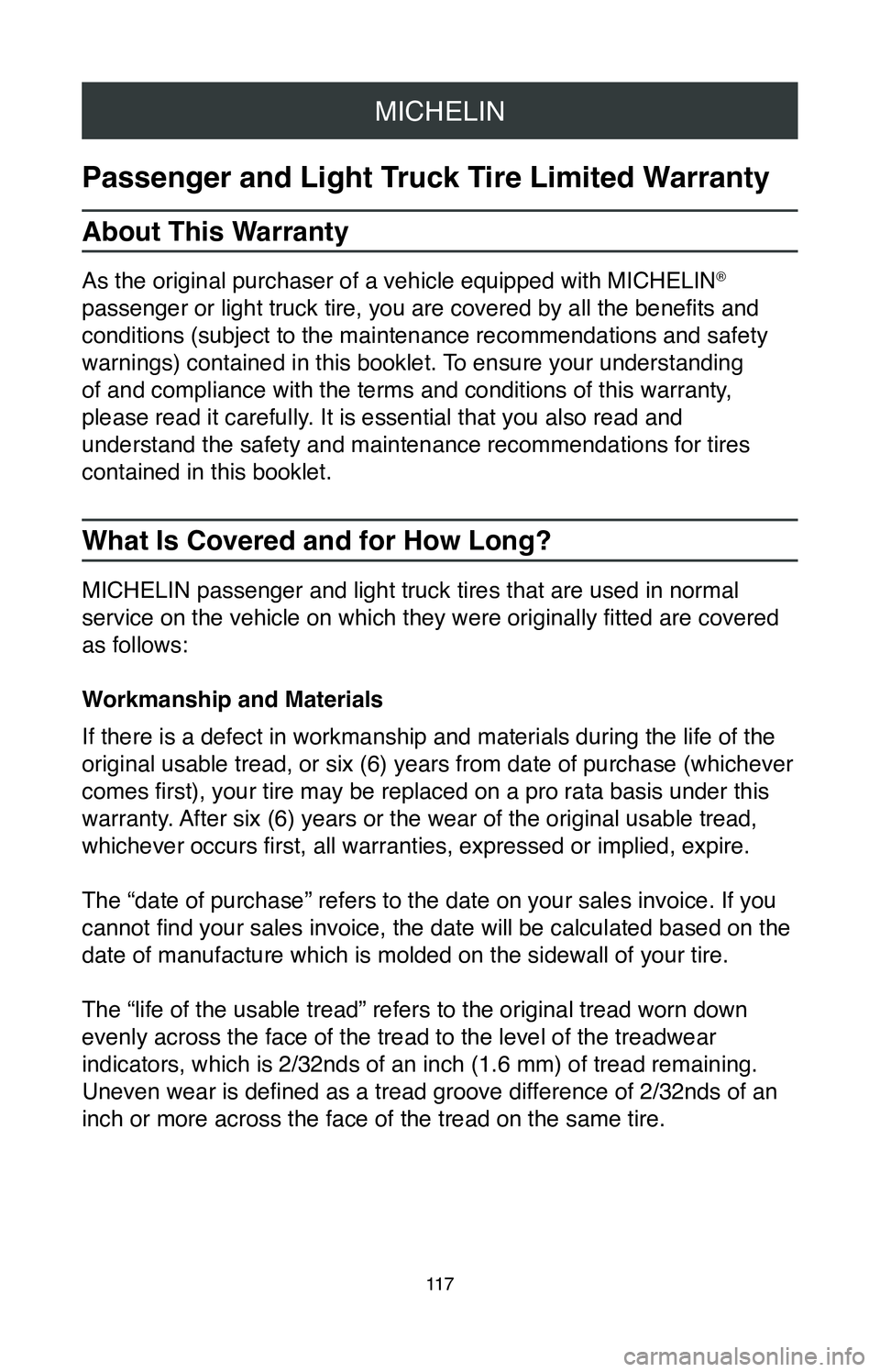
MICHELIN
11 7
Passenger and Light Truck Tire Limited Warranty
About This Warranty
As the original purchaser of a vehicle equipped with MICHELIN®
passenger or light truck tire, you are covered by all the benefits and
conditions (subject to the maintenance recommendations and safety
warnings) contained in this booklet. To ensure your understanding
of and compliance with the terms and conditions of this warranty,
please read it carefully. It is essential that you also read and
understand the safety and maintenance recommendations for tires
contained in this booklet.
What Is Covered and for How Long?
MICHELIN passenger and light truck tires that are used in normal
service on the vehicle on which they were originally fitted are covered
as follows:
Workmanship and Materials
If there is a defect in workmanship and materials during the life of the\
original usable tread, or six (6) years from date of purchase (whichever
comes first), your tire may be replaced on a pro rata basis under this
warranty. After six (6) years or the wear of the original usable tread,
whichever occurs first, all warranties, expressed or implied, expire.
The “date of purchase” refers to the date on your sales invoice. I\
f you
cannot find your sales invoice, the date will be calculated based on the
date of manufacture which is molded on the sidewall of your tire.
The “life of the usable tread” refers to the original tread worn d\
own
evenly across the face of the tread to the level of the treadwear
indicators, which is 2/32nds of an inch (1.6 mm) of tread remaining.
Uneven wear is defined as a tread groove difference of 2/32nds of an
inch or more across the face of the tread on the same tire.
Page 184 of 260
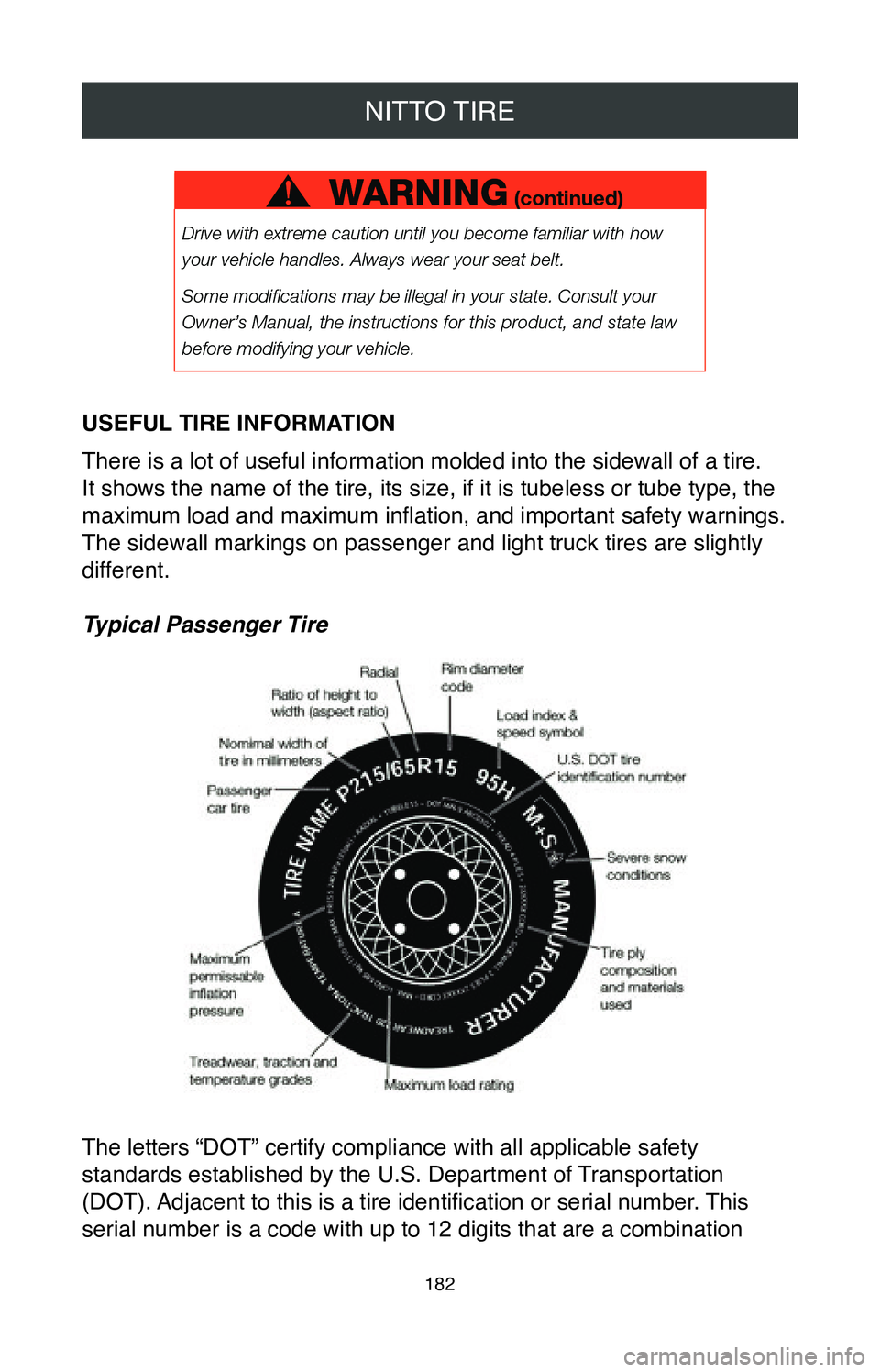
NITTO TIRE
182
USEFUL TIRE INFORMATION
There is a lot of useful information molded into the sidewall of a tire.\
It shows the name of the tire, its size, if it is tubeless or tube type,\
the
maximum load and maximum inflation, and important safety warnings.
The sidewall markings on passenger and light truck tires are slightly
different.
Typical Passenger Tire
The letters “DOT” certify compliance with all applicable safety
standards established by the U.S. Department of Transportation
(DOT). Adjacent to this is a tire identification or serial number. This
serial number is a code with up to 12 digits that are a combination
Page 207 of 260
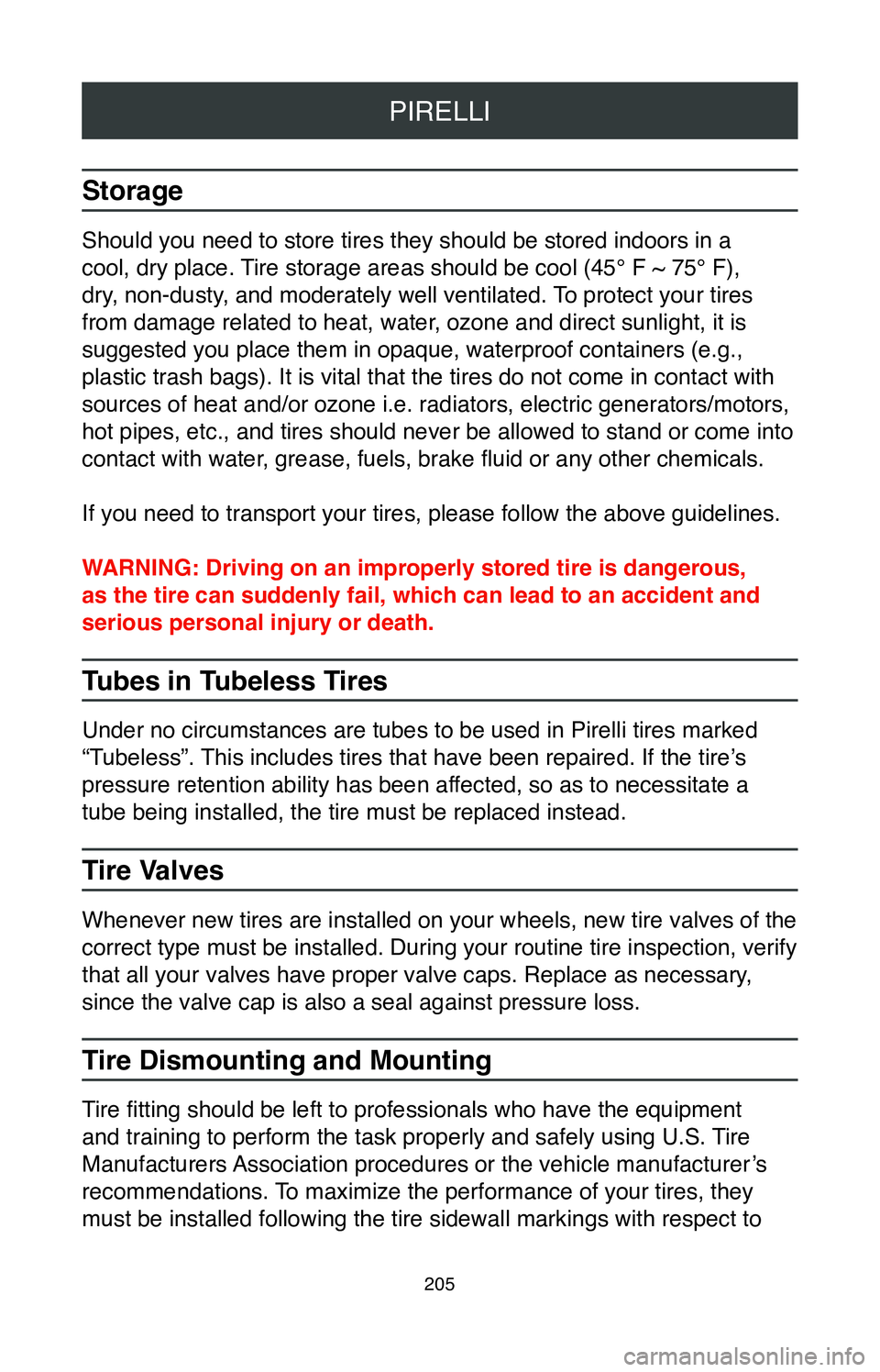
PIRELLI
205
Storage
Should you need to store tires they should be stored indoors in a
cool, dry place. Tire storage areas should be cool (45° F ~ 75° F),
dry, non-dusty, and moderately well ventilated. To protect your tires
from damage related to heat, water, ozone and direct sunlight, it is
suggested you place them in opaque, waterproof containers (e.g.,
plastic trash bags). It is vital that the tires do not come in contact \
with
sources of heat and/or ozone i.e. radiators, electric generators/motors,\
hot pipes, etc., and tires should never be allowed to stand or come into\
contact with water, grease, fuels, brake fluid or any other chemicals.
If you need to transport your tires, please follow the above guidelines.\
WARNING: Driving on an improperly stored tire is dangerous,
as the tire can suddenly fail, which can lead to an accident and
serious personal injury or death.
Tubes in Tubeless Tires
Under no circumstances are tubes to be used in Pirelli tires marked
“Tubeless”. This includes tires that have been repaired. If the tire’s
pressure retention ability has been affected, so as to necessitate a
tube being installed, the tire must be replaced instead.
Tire Valves
Whenever new tires are installed on your wheels, new tire valves of the \
correct type must be installed. During your routine tire inspection, ver\
ify
that all your valves have proper valve caps. Replace as necessary,
since the valve cap is also a seal against pressure loss.
Tire Dismounting and Mounting
Tire fitting should be left to professionals who have the equipment
and training to perform the task properly and safely using U.S. Tire
Manufacturers Association procedures or the vehicle manufacturer’s
recommendations. To maximize the performance of your tires, they
must be installed following the tire sidewall markings with respect to
Page 243 of 260
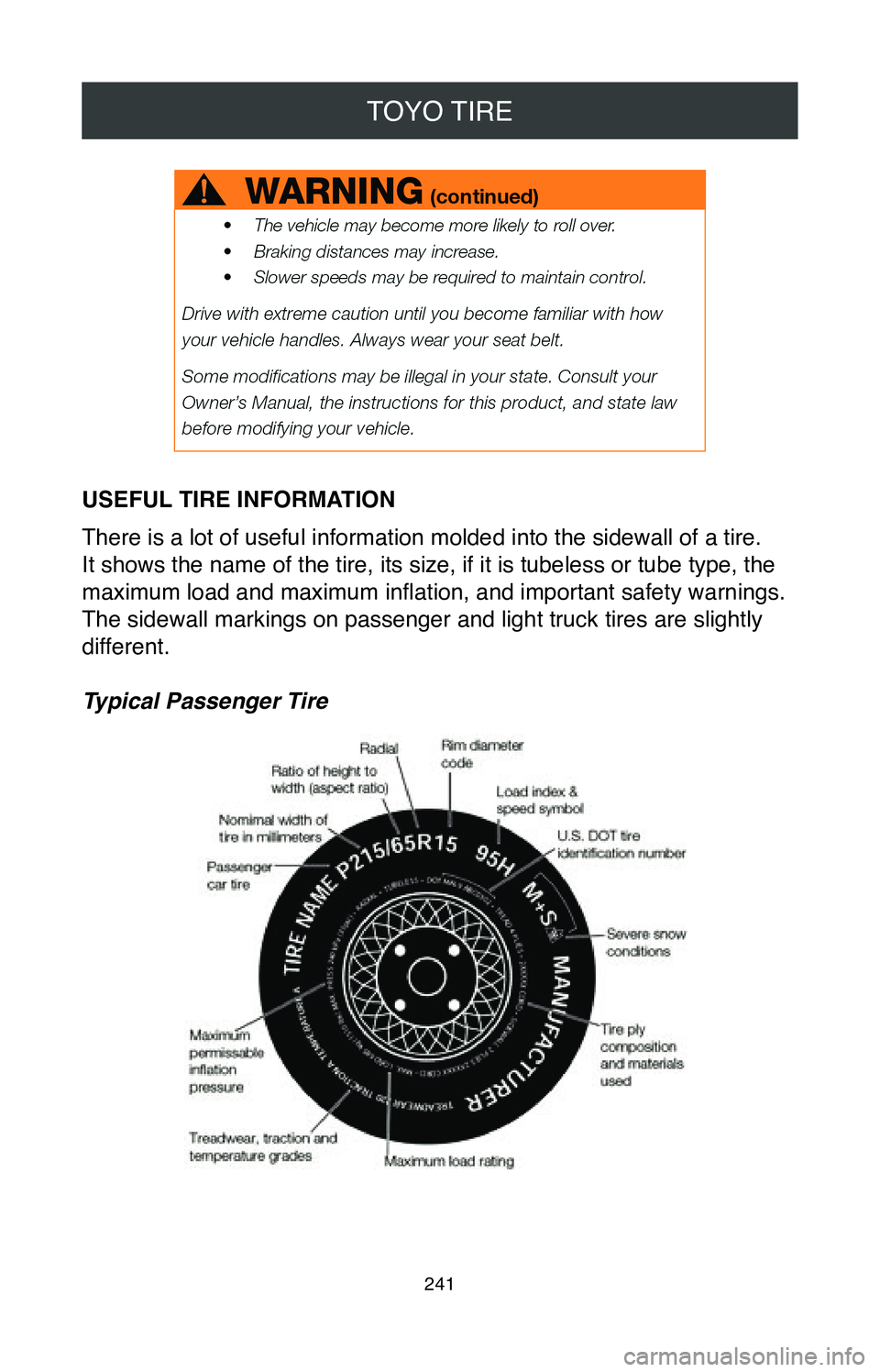
TOYO TIRE
241
USEFUL TIRE INFORMATION
There is a lot of useful information molded into the sidewall of a tire.\
It shows the name of the tire, its size, if it is tubeless or tube type,\
the
maximum load and maximum inflation, and important safety warnings.
The sidewall markings on passenger and light truck tires are slightly
different.
Typical Passenger Tire